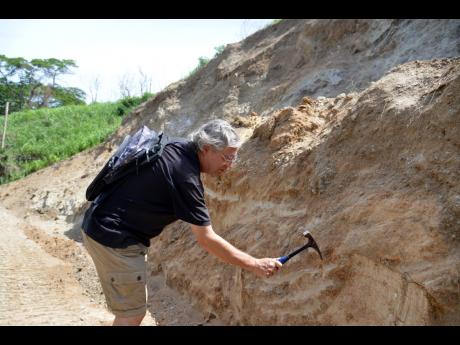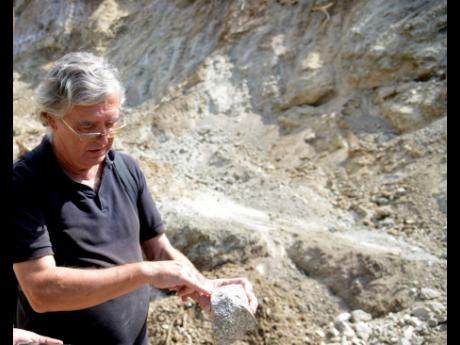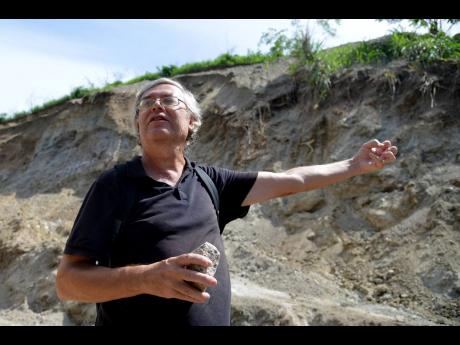Jack’s Hill developments ‘potentially problematic’, geologist finds
The multifamily housing developments taking place in Jack’s Hill, St Andrew, have been flagged as “potentially problematic” by Professor Simon Mitchell, the country’s foremost geologist. Mitchell’s position follows concerns raised by residents of...
The multifamily housing developments taking place in Jack’s Hill, St Andrew, have been flagged as “potentially problematic” by Professor Simon Mitchell, the country’s foremost geologist.
Mitchell’s position follows concerns raised by residents of the upscale community last week that four housing developments that are ongoing or at the beginning phase are a threat to community infrastructure or the single-family dwellings that have occupied the hillside overlooking Kingston for decades.
An application for a fifth multifamily dwelling has been put in, The Gleaner can report.
Mitchell, a professor of sedimentary geology and head of the Department of Geography and Geology at the University of the West Indies, Mona, told The Gleaner on Friday that the Wag Water Fault zone, 1.5 to 2.5km wide, runs through Jack’s Hill.
Drawing on the findings from his research and “extensive” mapping of the area, Mitchell said the fault zone is not a single line as believed to be the case by many people.
He told The Gleaner that there are three fault lines at the location – one at the base of the hillslope that brings up limestone; another higher up, which brings up igneous rocks; and a third at the top, which brings up conglomerates of what is known as the Wag Water Belt.
“Now, there are a number of issues in that. If you’ve got a big fault there like that, the rocks are going to be messed up in it,” Mitchell asserted. “They’re going to be broken; they’re going to be shattered. There are a lot of igneous rocks in there, they get very weathered, and they, basically, turn into soil. So they don’t have any form of consistency to them.”
He said that as a result, moving from Skyline Drive as far up and across to Stony Hill, there is a zone of deformed rocks.
Very soft rocks
Mitchell, whose research areas also cover palaeontology, stratigraphy, and sedimentology, noted that the eastern side of the hill has been “faulted up” some 12km relative to Liguanea on the western side.
“Now, you think about that much movement and what that is going to do to the rocks adjacent to it. It’s going to deform it dramatically.
“So what you end up with is very soft rocks, very weathered, and you end up with a very big problem in the fact that they are not going to easily take you cutting roads through it or building large high buildings on it,” said Mitchell.
The National Environment and Planning Agency (NEPA) has remained mum on the issue and the conditions under which these multifamily dwellings are permitted to take place.
The state agency responsible for “managing and protecting Jamaica’s land, wood, air, and water” did not respond to a Gleaner request for information pertaining to the developments.
The Kingston and St Andrew Municipal Corporation (KSAMC) which, in recent years, has drawn heavy criticism from several sectors including environmentalists, has also not responded to a similar request.
Robert Hill, KSAMC’s CEO, who initially said that the agency needed time to respond to The Gleaner’s request last Tuesday, has since not responded to multiple queries for an update.
Mitchell said that while construction can take place, it would require significant resources and highly skilled engineers.
He said that to get it right would come at a great cost to developers but that if shortcuts are made, there would be problems.
“You’ve got very big slopes there, and if you load those slopes, they can fail, and they will fail at depths. These rocks are just igneous rocks. So unless you’ve penetrated the pile sufficiently deep, you end up with a problem that you may not have done it far enough, and the whole building can essentially go down a slope,” he said while acknowledging that he was not aware of the engineering solutions being used.
He noted, too, that covering the area with buildings or parking lots will affect infiltration while triggering an increase runoff.
The professor said this would end up going down gullies, creating a “bigger” erosion problem, noting that these developments require adequate drainage system.
“There are a lot of questions that could be raised as to whether people are doing it the right way … . I have no agenda to push. What I want is for the [development] to take place on the level of the science so that you understand and people use it appropriately,” he said.
“I won’t make judgement calls on how somebody is building something, but I will make comments. This is a difficult area, and you’ve got to build properly,” Mitchell added.
Last week, The Gleaner reported that at least four new housing developments were either ongoing or set to begin, triggering significant pushback from Jack’s Hill residents and in particular those living on Tavistock Terrace.
Checks by The Gleaner revealed that AVS Builders Limited is the company behind one of the developments – a luxury apartment complex on just over five acres of land – in the upper St Andrew community.
St Ann businessman Arthur Von Strolley and Jordan Von Strolley are the listed shareholders in the company undertaking the development known as The Spyglass, which residents have associated with Government Minister Daryl Vaz.
But speaking with The Gleaner on Friday, Vaz denied having anything to do with the project, noting that he and his brothers had simply sold land owned by them to a developer.
Documents reviewed by The Gleaner revealed that AVS Builders bought the land for US$1.3 million or approximately J$200 million in June 2019.
...Vaz: I have no involvement in Tavistock development
Daryl Vaz, the minister of science, energy, telecommunications and transport, has denied involvement in The Spyglass in Tavistock Terrace, St Andrew, which is one of four developments, which has raised concerns among residents of the area.
Vaz told The Gleaner on Friday that he and his brothers became owners of land in 2003 before he entered representational politics in 2007.
He said that, during the land acquisition, investigations were done in relation to the usage of the land, including the hiring of an engineer for geotechnical purposes.
“We transferred that land as part of a joint venture to a developer. I have no involvement after transferring the land. We have no involvement in the construction, financing, or any other aspect of the development,” Vaz insisted.
He said he and the developer met with residents “out of good order and neighbourly respect” after he had reached an agreement to transfer the land.
He said that the meeting was for the developer to explain his concept for the land.
“That was the extent of my involvement in the development,” he said, adding that residents raised “certain concerns and recommendations”, which the developer included in his final concept for approval.
He said persons associating him with the project are political activists seeking to create “political mischief”.
Two other developments, being funded by St Lucia-registered company Connect 4 Incorporated and Avatar Development, have evoked strong concerns from residents who argue that they have contributed to land slippages and infrastructural damage.
A document seen by The Gleaner revealed that businessman Peter Azar is a director of Connect 4 Incorporated, the company contracted by developer Kennado Nesbeth of KNN Designs and Construction Limited to undertake a multifamily townhouse development on three acres of land.
Connect 4 Incorporated acquired the land in December 2005 at a consideration of $6 million.
In a Gleaner interview on Thursday, Azar denied the allegations that work on the land caused a landslide just over a week ago. He said what residents saw was dirt dumped on an already inaccessible.
“We didn’t breach any regulations. Our engineer has programmed some walls for the property. They are massive walls, and we just wanted to confirm his findings about the soil so that when and if there is approval, we would know from doing a borehole test,” he said.
He said tha, to do the test, Nesbeth needed to cut an access road to get up the hillside as eight holes were needed at different points — a final requirement for approval from the KSAMC.
Azar said his only error was to dump dirt on the minor road and his failure to move it in a timely manner because of a mechanical failure with the backhoe being used.
“I did nothing wrong. We crowded up the road with soil. There was no landslide,” he said, insisting that the road had already been made impassible due to another development.
He was referring to Avatar Development, where seven townhouses and two apartments are to be constructed.
Developer Tariq Malik has argued that the breakaway of Tavistock Terrace and subsequent landslide was “no one’s fault”.
He said work began on the project in January 2022, and a year later, during further excavation, it was discovered that there was a “leak” beneath the hill, caused by a worn 10-inch pipe and a faulty hydrant.
“It saturated the entire hillside,” said Malik.
He said that the initial leak “was so minor it was negligible”, but a subsequent attempt by the National Water Commission to fix the issue resulted in a greater problem.
The saturated hillside ultimately led to the breakaway of a section of Tavistock Terrace.
The fourth development, Tavistock Vistas, was commissioned by Solerno Estates Limited. Records at the Companies Office of Jamaica list Kirk Holbrooke and Melissa Chin Holbrooke as the company’s two directors.
A letter to residents, seen by The Gleaner, said work is scheduled to be completed in 24 months and that “all construction will be done in accordance with government permits and licences”.
An application has been made to the KSAMC for a permit for a fifth multifamily housing development. The application was made in September 2022, according to the KSAMC’s website.
The land is mortgaged by JMMB Bank.
...JET founder declares KSAMC ‘reckless in the extreme
Founder of the Jamaica Environment Trust, Diana McCaulay, on Saturday criticised comments made by city engineer Xavier Chevannes that there are engineering solutions that can be applied to make building on Jack’s Hill safe.
McCaulay, an environmental advocate, said Chevannes’ thinking is “outdated”.
“Vulnerable sites should be avoided, especially in the Jamaican context of inadequate monitoring of engineering solutions, maintenance failures of manmade structures over the longer term and the changing climate, which includes heavier rainfall over short periods and in the case of the coast, sea-level rise,” she said.
McCaulay slammed the KSAMC, which she said was “reckless in the extreme” for giving permission to cut an access road to do soil testing at the Tavistock site in Jack’s Hill where residents have been raising concerns about the impact of four new developments in the area.
“Roads are often the catalyst for landslides. And why would a road be allowed in advance of the development being permitted? Suppose it was denied?
“Our regulators seem to have the view that once one development is allowed in an area, there is no basis to deny subsequent ones. This flies in the face of current understanding that places have limited carrying capacities. We have so far been very slow to establish or enforce those carrying capacities in many vulnerable areas, including the coast,” she argued.
McCaulay said a permit must come from the National Environment and Planning Agency for developments over a certain size under the Natural Resources Conservation Authority Act. However, she argued that the state regulator is “not being sufficiently cautious regarding the underlying geology”.
As a result, the environmentalist said the concerns of residents are “entirely valid”.
Eleanor Jones, a retired geomorphologist and resident of Jack’s Hill, noted that residents’ concerns were grounded in the water supply issues they are experiencing, occasional fires, intense traffic, and an expected increase in water runoff.
“The infrastructure to support what [is being done] is inadequate. We don’t have water. We don’t have roads. We don’t have no wastewater disposal system. How are we going to handle all that? Where is the planning for this?
“We need to integrate what we’re doing and not just say, ‘Okay, here is a piece of land that looks clear. Let’s put up a structure’. We have the science. All of that area has been mapped thoroughly. The data is available for use. So we must underpin what we’re doing by the scientific method if we want our investments to last. The person doing the development has as much to lose as the poor unsuspecting persons who buy these [properties],” the former University of the West Indies lecturer said.
Jones dismissed suggestions that residents’ concerns were because of gatekeeping, noting that it is a “populist” argument used by developers “which doesn’t hold water”.
Jones, who has lived in Jack’s Hill for more than three decades, said residents are not opposed to developments but are concerned that the high-density types are not appropriate for Jack’s Hill.




